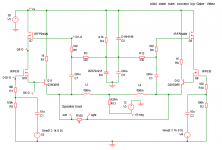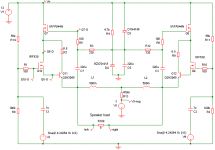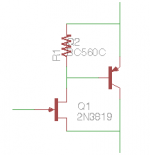Hi all,
I've been fretting over the obsolescence of the LU1014D power jfet. In my search for a suitable replacement, I stumbled across Gabe Velez's web site. He suggests a mosfet/bipolar configuration to duplicate the "tube" sound. I'm submitting a differential simulation I ran and would appreciate some feedback. You can see the mosfet/bipolar combination in the middle horizon of the drawing.
Best,
John
I've been fretting over the obsolescence of the LU1014D power jfet. In my search for a suitable replacement, I stumbled across Gabe Velez's web site. He suggests a mosfet/bipolar configuration to duplicate the "tube" sound. I'm submitting a differential simulation I ran and would appreciate some feedback. You can see the mosfet/bipolar combination in the middle horizon of the drawing.
Best,
John
Attachments
Wavebourn said:Sure, it will sound clean, but power dissipation will be the price for sound quality. Here is what I use for output stages, drivers, and line outputs:

Thanks for the drawing. I need a bit more detail with regards to the power/signal sources.
Regarding my circuit: yes, the sim depicts rather poor efficiency.
I'm going to build it for kicks, just to see how it sounds. The LU1014D has such a beautiful sound. I'm hoping the mosfet/bipolar combo will sound as sweet.
carpenter said:
Thanks for the drawing. I need a bit more detail with regards to the power/signal sources.
Regarding my circuit: yes, the sim depicts rather poor efficiency.
I'm going to build it for kicks, just to see how it sounds. The LU1014D has such a beautiful sound. I'm hoping the mosfet/bipolar combo will sound as sweet.
For better efficiency I use modulated in counter-phase current sources.
It was used long time ago in White cathode follower, but current source was modulated by feedback by current that depends on load impedance. In my version it is modulated feed-forward.
Bootstrapping follower on top of cathode follower was used long time ago, in Tekronix oscilloscopes, it was called Augmented Cathode Follower.
I was looking for ways to minimize modulations of parameters of a source follower and come to this combination. It can't be patented, I believe, because both of approaches were used before, in test equipment, long time ago. And second, it can't be patented because it is already in public domain, I drew schematics that use such approach on many online forums.
carpenter said:Fascinating! I'll have to explore your concepts further.
Here is one practical schematic (though not breadboarded yet), I've made it from my previous version of the amp eliminating one power source and one bootstrapping source follower on top, it works also very nice such a way. Just set standing current equal to half of peak current needed to drive the lowest impedance your speaker has, and you get a single ended amp with maximum of effeciency available. If you set a standing current equal to peak of current through the load, the source follower will see almost stable load current (however, not so stable since real speaker is a complex load).
http://wavebourn.com/images/audio/Tower-III.gif
Currently, I build a full version again, with some sneaky tricks, it is not in public domain yet since I plan to get some money for my future projects.
You can see the thread in Tube forum, about my Pyramid design. I describe the process of building of a Designer's prototype, step by step.
carpenter said:I appreciate your gift of knowledge.
Thank you!
Actually, it is typo: I meant Tower thread, not Pyramid. Pyramid is a pure tube amp on MOSFET voltage regulators.
Lumba Ogir said:carpenter,
in the absence of something better, the LU1014D is not obsolete (maybe unobtainable). Generally, JFETs are preferable to MOSFETs. I cannot see why that circuit, particularly the lousy (and much more obsolete) N3055, could produce a "tube sound".
Why not? 2N3055 are used as single ended emitter follower, so no "transistor sound" can be made such a way.
Lumba Ogir said:carpenter,
in the absence of something better, the LU1014D is not obsolete (maybe unobtainable). Generally, JFETs are preferable to MOSFETs. I cannot see why that circuit, particularly the lousy (and much more obsolete) N3055, could produce a "tube sound".
The 3055 is easy to locate, the LU1014D is a bear to find at a reasonable price. The 3055 can be replaced with another bipolar, the power jfet can't.
The output sine in the sims on the 3055 (in my circuit) have a strong resemblance to the power jfet output sine.
Makes for an entertaining evening, yes?
Thanks for the corroboration, Wavebourn
I made a few mods to the circuit and managed to reduce the power consumption by half. It's still a power hog, and I have a bit of studying to do before I can improve further. Sim specs are good: 2nd harmonic at 4.5 watts = 0.0002%. 3rd harmonic = 0.1%
Attachments
carpenter said:The 3055 is easy to locate, the LU1014D is a bear to find at a reasonable price. The 3055 can be replaced with another bipolar, the power jfet can't.
I have lots of them. How many do you need?
I don't like curve 4: http://pdf1.alldatasheet.com/datasheet-pdf/view/131319/ETC/LU1014D.html
However, 24V breakdown may be not a problem, if to use them in cascodes.
However, 24V breakdown may be not a problem, if to use them in cascodes.
Nelson Pass said:
I have lots of them. How many do you need?

You really are a sweetheart of a guy...
I have a small stash, but over time, it will become depleted. When I'm empty, perhaps I can purchase from you if you still have some in stock.
In the meantime, if there's anything I can do for you... I'm a very good carpenter with a Sprinter van loaded with tools.
Wavebourn said:I don't like curve 4: http://pdf1.alldatasheet.com/datasheet-pdf/view/131319/ETC/LU1014D.html
However, 24V breakdown may be not a problem, if to use them in cascodes.
Are you referring to the top trace, or the bottom? I'm following the bottom curve as much as possible. Like Nelson mentions, it has a concave character that resembles a triode.
Wavebourn,
Although no serious crossover artifacts, still considerable high order harmonic and IM distortion is created (even with more linear and much faster bipolars than 2N3055). You get closer to the tube sound with FETs.Why not? 2N3055 are used as single ended emitter follower, so no "transistor sound" can be made such a way.
Lumba Ogir said:Wavebourn,
Although no serious crossover artifacts, still considerable high order harmonic and IM distortion is created (even with more linear and much faster bipolars than 2N3055). You get closer to the tube sound with FETs.
People seem to love the sound of the original JLH Class-A amplifier...
Lumba Ogir said:Wavebourn,
Although no serious crossover artifacts, still considerable high order harmonic and IM distortion is created (even with more linear and much faster bipolars than 2N3055). You get closer to the tube sound with FETs.
Depends on many circumstances. Why do you think in FET output stages I prefer to use BJT current mirrors?
I hope the revived amplifier i am working on, a Sony TA-N7B will sound that good as their owners say. It has an hybrid bipolar/Vfet output stage, and a very nice (DC coupled) circuit wth current sources and so on.
To get that tube like sound maybe try those obsolete Sony Vfets. On ebay there is on this very moment an auction for 30Eu a piece, not that bad for new Vfets.
http://cgi.ebay.nl/ws/eBayISAPI.dll?ViewItem&item=220383471581
Hitachi 2sj50's remakes are priced around the same now.
An externally hosted image should be here but it was not working when we last tested it.
To get that tube like sound maybe try those obsolete Sony Vfets. On ebay there is on this very moment an auction for 30Eu a piece, not that bad for new Vfets.
http://cgi.ebay.nl/ws/eBayISAPI.dll?ViewItem&item=220383471581
Hitachi 2sj50's remakes are priced around the same now.
- Status
- This old topic is closed. If you want to reopen this topic, contact a moderator using the "Report Post" button.
- Home
- Amplifiers
- Solid State
- Solid state tube?


